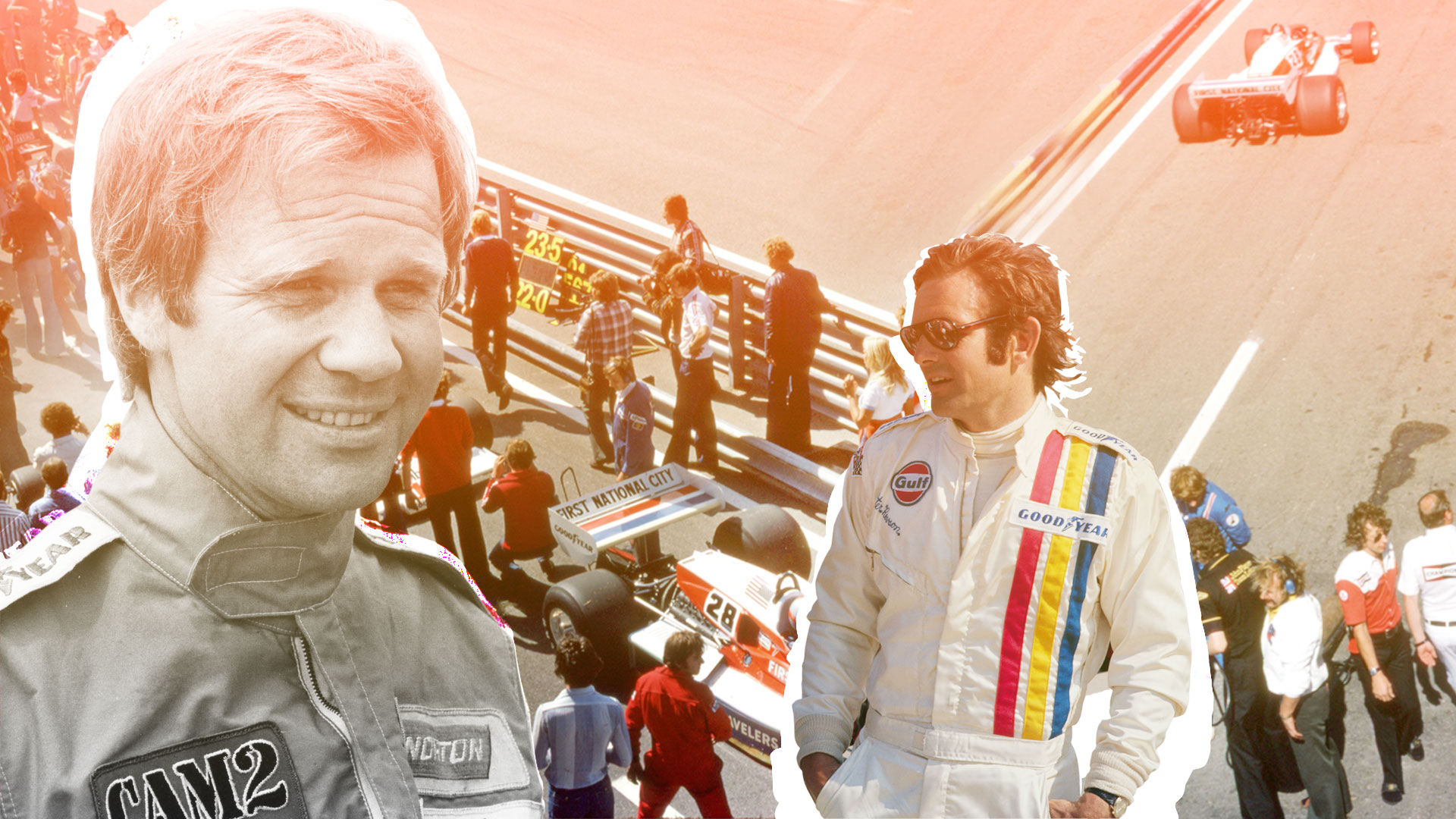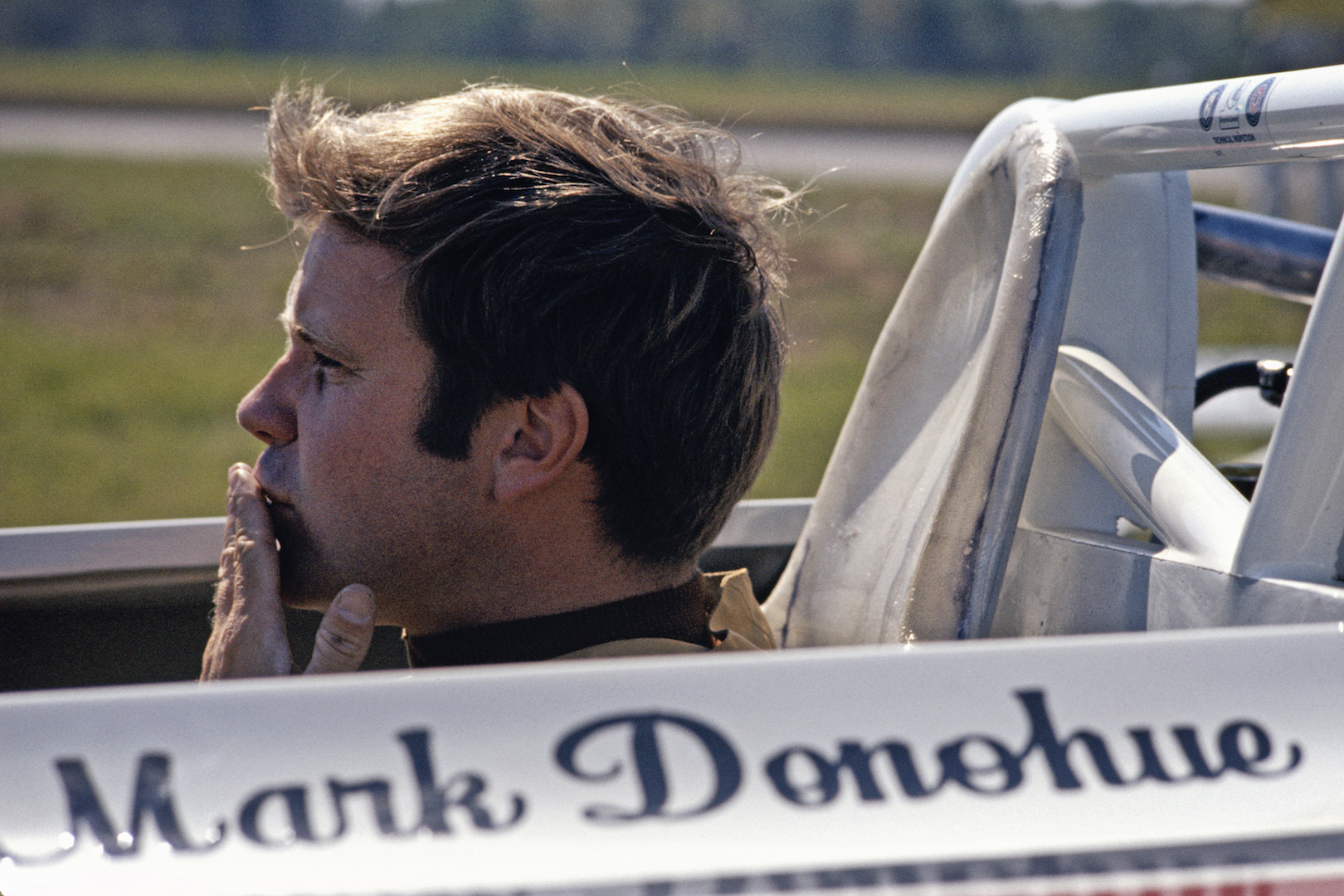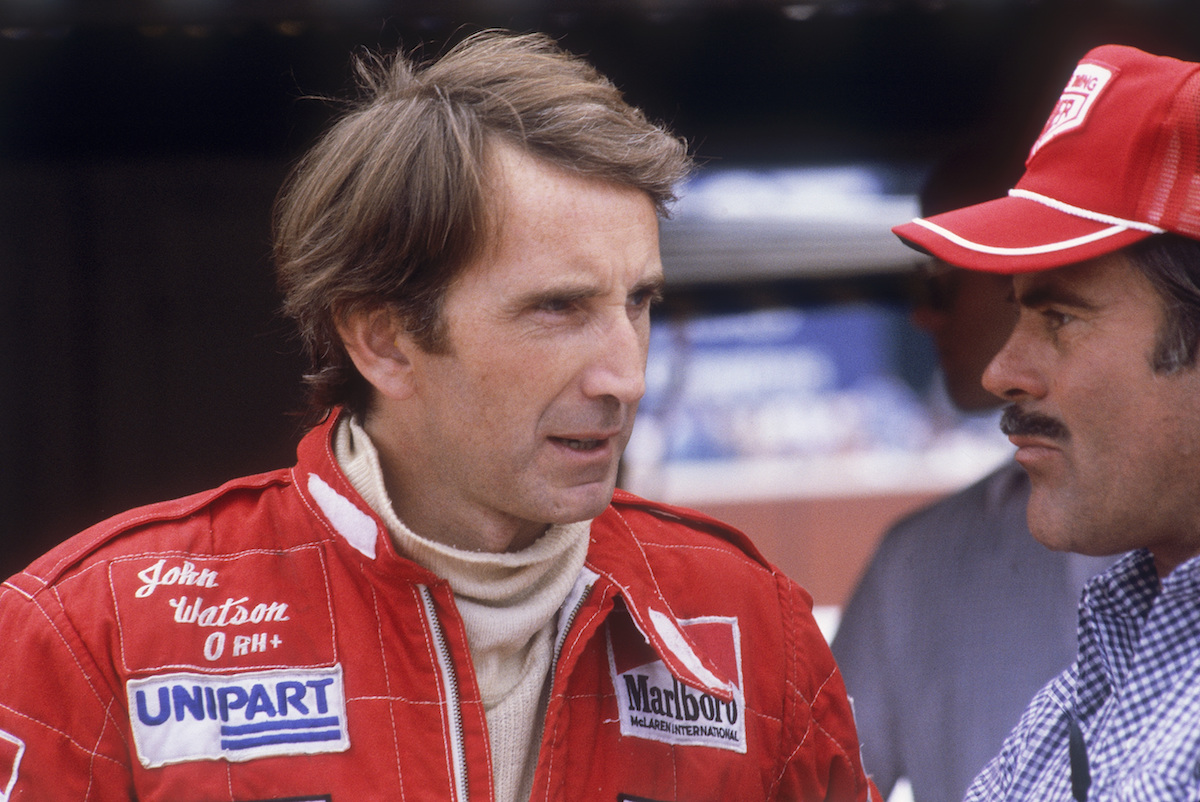

“If you’re going to be in a racing car, you drive mile after mile after mile. Sooner or later, the odds are you’ll make a mistake or somebody working on the car will make a mistake, or the guy who designed the car will have made a mistake. When that happens, generally you lose control. But if I get wiped out, and they carry me away in a box, I wouldn’t expect anybody to feel sorry for me. It’s something I know is a possibility, and I’m not complaining.” —Mark Donohue
With the American-owned Haas F1 Team making its debut this season as a solid middle-of-the-pack runner, an obvious question presents itself: When was the last time a U.S. team won a race in F1? The answer: Forty years ago this week. The particulars of that win tell a bittersweet story—about a rivalry, a friendship, a legendary driver, and the largely-forgotten beginnings of a team you thought you knew everything about.
Rewind to the late 1960s and the gap between F1 and American racing wasn’t nearly as wide as it is today. Indy cars (then called Champ cars) raced almost exclusively on ovals. But drivers bounced back and forth between the U.S and Europe. In 1967, Dan Gurney upped the ante by designing and building the Eagle-Westlake, a car that won the Belgian Grand Prix. Gurney’s Eagle is remembered not only for its pedigree but its sex appeal: It’s often called the most beautiful F1 car of all-time. It was also the first U.S.-built car to win a Grand Prix. The first of only two.
As the 1960s rolled into the 1970s a new generation of American F1 drivers joined the grid, notably, Mario Andretti and Peter Revson. With promising American drivers battling in F1, why not build an American car? Starting an F1 team wasn’t the multi-billion dollar effort that it is today. Most cars, with the notable exception of the Ferraris, used the same Ford Cosworth engine and the same Hewland gearbox. The chassis? A hand-welded alloy frame with a thin aluminum skin. Carbon fiber was still a decade away. Tyrrell cobbled together a championship-winning car for Jackie Stewart in a garage in England in just a few months, proving that building a competitive F1 car on a modest budget was an attainable dream.
In 1973, the stealthy all-black Shadow appeared, built by a U.S.-based team owned by Don Nichols, who may or may not have been a CIA operative. At the end of the 1974 season, two more American cars appeared: the Maurice Phillipe-designed Vels Parnelli VPJ4 (driven by Mario Andretti among others) and the Penske PC-1.

Mark Donohue
You can’t tell the story of Penske racing—and its single F1 win—without telling the story of Mark Donohue. Donohue was a driver ahead of his time. He was an Ivy league-educated engineer—he earned a B.S. in mechanical engineering from Brown—crunching numbers at a time when most mechanics set up racecars by greasy guesstimation. Born into the age of socket wrenches, not laptops, Donohue gave Team Penske the so-called Unfair Advantage. He not only gathered data—call it human telemetry—he also analyzed it on the fly. Donohue knew how to make a car go faster and he was able to communicate it to his mechanics.Sports Illustrated called him “the American driver who exemplifies the best in automotive science and road-racing cool.”
Or maybe not so much cool. Donohue was polite and sported corn-fed good looks, which earned him the nickname Captain Nice. But despite his massive success—he won Indy in 1972—he was also insecure. Hence his other moniker: Dark Monahue.
He often seemed to like cars better than people. The sign he posted in the Penske garage—Those of you who think you know it all are particularly annoying to those of us who actually do—would work on the set of Big Bang Theory. Even though he was a thirtysomething divorced dad with two sons, he lived in a crash pad above the Penske shop, all the better to get an early start following a late night working on the car. His memoir, entitled The Unfair Advantage, told his life story one car at a time. In other words, Mark Donohue was a proto geek.
The best way to get a handle on Donohue is by comparison to his main rival, Peter Revson. The Donohue and Revson clash is more than a bit like the rivalry between Niki Lauda and James Hunt depicted in Rush. If Donohue was nerdy and analytical, Revson could have been Hunt’s role model. He was born into American royalty, an heir to the Revlon cosmetics fortune. He was movie star handsome and he knew it. He traveled in the loftiest circles. He dated Marjorie Wallace, a former Ms. World, and his co-driver at Sebring was an actor-turned-racer named Steve McQueen. Revson, you see, was the guy that the King of Cool took his cues from.
Revson was no dilettante. He qualified on the pole at Indy, ahead of Donohue in an identical McLaren, and was an instant success in F1. He won two races in 1973, beating Jackie Stewart and Emerson Fittipaldi. (Revson remains the answer to a much-asked trivia question: Who is the last American-born driver to win a Grand Prix? Mario Andretti, the obvious answer, was born in Italy.) By comparison, Donohue’s F1 resume was tantalizingly brief—one race and one podium on a familiar track in Canada. There was one more important difference between Donohue and Revson. While Revson had access to virtually unlimited family wealth, Donohue did not; he was a world-class racing driver at a time when Indy 500 winners didn’t fly in private jets.
At the end of the 1973 season after seeing his close friend Swede Savage die at Indy, Donohue won the first International Race of Champions—barely edging out Revson—and promptly announced his retirement. “Mark, this is a fabulous moment. You are really going out in style,” said Jackie Stewart. “The way you retired is a mark of class.” It was a storybook ending to a legendary career.

Peter Revson at Brand’s Hatch; he died a week later
Until it wasn’t. In 1974 Donohue assumed the role of President of Penske Motorsports. He found his new gig unfulfilling. Other drivers couldn’t give him the kind of detailed feedback about the car’s behavior that he was used to getting from his own backside. And the new job didn’t pay nearly as well, at a time when the newly re-married Donohue needed the money. “I didn’t think I’d miss driving this much but I can tell you it’s no fun watching,” Donohue said. “I feel so far removed from everything. I’d be happy just testing cars again. I appreciate that Roger is keeping me involved but it’s just not the same.”
Donohue’s rival Peter Revson signed with Penske to replace him at Indy in 1974. And when Penske began to plan an F1 car late in 1973, Revson was the front runner for the drive. Sadly, while testing for the 1974 South African Grand Prix, Revson was killed while driving a Shadow. This left the Penske F1 effort without a driver, and a president who’d rather be turning hot laps. The outcome was inevitable.
Every racing fan knows Roger Penske and the racing empire he built. But few fans remember that Penske competed in F1, and fewer remember how his F1 program changed the direction of the company. For its first decade, Penske was a privateer team. He didn’t build cars. He either teamed up with a factory (American Motors, Porsche) or bought cars outright (from the Ferrari 512 Le Mans racer to a McLaren M-16 Indy car.) This was a well-established tradition in motorsports from the late 1950s to the early 1970s. Penske took it to the next level, turning out impeccable cars that were cleaner, and faster, than the factory models. Despite the team’s compulsive organization and its almost fanatical attention to detail, Penske had never built its own car. Even that legendary, series-killing 1,500-horsepower Can Am car was a Porsche, not a Penske. Until, that is, Penske hit F1. The Penske PC-1 was not revolutionary, nor was it especially fast or successful. It was just another Hewland/Cosworth F1 car. But it was historic in one important way: it was the first car to wear the Penske name.
In contrast to the team’s massive presence today, the Penske F1 team was, to be charitable, minimalist. “We had only five people going to the races that year,” recalls team engineer Karl Kainhofer in Penske’s Maestro, the memoir he wrote with Gordon Kirby. “There was Mark, [team manager] Heinz [Hofer] and three of us working on the car—myself, Bill Woodland and Greg Syfert. That was it. The whole F1 team was five guys.”
This tiny band of expats found F1’s learning curve steep. Donohue, who knew every track in North America by rote, was forced to cram at Zandvoort, Silverstone, and the Nurburgring. Monaco proved an especially tough lesson. The team brought 13 wheels to the street circuit. By the time they returned to their small shop in England there wasn’t a single one left un-bent.
Midway through the 1975 season, development of the PC-1 stalled, and the ever-pragmatic Roger Penske bought a customer March 751. The car was decent, and the team’s expertise at making a decent car better came to the fore. Donohue finished fifth in Sweden and repeated the performance in a rain-soaked race at Brands Hatch.

Then came the 1975 Austrian Grand Prix. Donohue qualified the March 20th, just ahead of Lella Lombardi, the only woman to earn points in an F1 race. During the pre-race warm-up Donohue’s left front tire blew at Vost-Hugel, one of the fastest turns in all of F1. “It was one of those corners that separates the men from the boys,” recalls Derrick Walker who would later become Penske’s chief mechanic. “You’re very committed.” Donohue’s March flew off the road and hit a post, tearing up 50 yards of catch fencing along the way. Two marshals were killed by flying debris. “As bad as it looked, Mark was conscious and he appeared to have survived it okay,” recalls Penske press officer Dan Luginbuhl.
But the situation grew critical, all of the sudden. Donohue lost consciousness from an undetected cerebral hemorrhage. He was airlifted to a nearby hospital but to no avail. Three days later, he died at the age of 38.
Race teams are world-class compartmentalizers. If they weren’t able to keep fear and grief at arm’s length, they wouldn’t be able to show up at the track every weekend. And in the 1970s, losing a driver was a tragedy but not totally a surprise. So the Team Penske members honored Donohue in the best way that they knew how: They set about building a truly competitive F1 car.
“When we lost Mark it certainly was devastating for all of us,” Penske recalls. “It was definitely tough, but we made the decision to keep moving forward as a team. That is the way he would have wanted it.”
Team Penske withdrew from the Italian and Canada GPs, but returned for the U.S. GP at Watkins Glen with John Watson of Northern Ireland behind the wheel. The next generation Penskes, the PC-3 and PC-4, hit the grid in 1976, and the latter became a truly-competitive car. In its second race in France, Watson earned his first podium and did it again in the British Grand Prix.
Then came the Austrian Grand Prix, which marked one year since Donohue’s death. Watson put the Penske on the front row next to Hunt’s McLaren. Even a last-minute gremlin that threatened to end Penske’s day before it began couldn’t halt the team’s momentum. “We had to do a panic change on this diaphragm in the fuel metering unit a half hour before the race,” Walker remembers. “We had all this drama building, but we rushed it out to the grid and John took it from there. He was flying.”
In the opening laps, Watson diced with Ronnie Peterson’s March and Jody Scheckter’s Tyrrell but as the race wore on, he simply drove away from the rest of the field. “It was one of those special days,” Watson recalls. “Considering everything that had gone on before, it was the right thing to have happened,” says Walker. “It was a big victory for our team,” says Penske. “And it was important to us that we were able to get it done at Austria – a place that was so difficult for everyone the year before with the loss of Mark.”
There are wins that are the result of circumstances—bad weather, a perfectly timed pit stop, a key rival’s bad luck. But Watson’s win in the Penske was legit, a simple case of a fast driver piloting a fast car to victory. Earning fifth place in the season-long Constructor’s Championship with a one-car team, Penske provided proof that a U.S.-based team could win in F1.
Then, almost as suddenly as it started, the experiment was over. In mid-December Watson got a call from Roger Penske. The team was pulling out of F1, effective immediately. “It was a bolt of lightning,” Watson recalls. Penske: “With the amount of racing that our teams were doing back in the U.S. and with Formula 1 as well. It just became too difficult to compete in all these series and race at the level that we wanted.”
Watson would head to Brabham, where he drove the wild Gordon Murray-designed BT-45, and later McLaren, where he’d win four more races. Walker would oversee the repurposing of the F1 shop in Poole, England, which would go on to build the team’s first Penske-branded Indy cars, including Rick Mears’ 1979 Indy 500 winner. And Donohue? He’s buried in a small cemetery in Summit, NJ, where race fans pay their respects by leaving toy racecars on his headstone. His Indy winning McLaren M-16 currently sits at the Indianapolis Motor Speedway Museum as part of an exhibit commemorating Penske’s 50th Anniversary. About 100 feet away from that car sits a Penske PC-4—the last American car to win an F1 Grand Prix, forty years ago this week.
Allen St. John is the New York Times bestselling author of Clapton’s Guitar and The Billion Dollar Game.